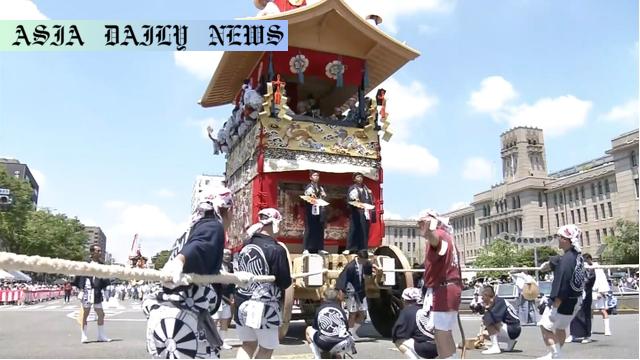Gion Festival: Ornately decorated floats paraded through Kyoto, showcasing scenes from Japanese history and cultural traditions.
Gion Festival showcases 11 ornately decorated floats in Kyoto.
The festival has a 1,000-year history rooted in prayers to end a plague.
Spectators watched as floats navigated sharp turns using traditional bamboo sticks.

Introduction to the Gion Festival
Kyoto’s Gion Festival is celebrated as one of the most iconic and culturally rich events in Japan, offering visitors a glimpse into the traditions of the country that have been preserved for over 1,000 years. Held annually in Kyoto, the festival is known for its grand parade filled with ornately decorated floats, which serves as both a living art form and a historical narrative. This event stands as a testament to the enduring spirit of Japanese culture and heritage, and it attracts thousands of spectators from around the world who gather to witness the mesmerizing spectacle.
The Significance of the Floats
The 11 floats featured in the Gion Festival are breathtaking in their intricate craftsmanship and storytelling. Each float depicts historical or mythological scenes rooted deeply in Japanese culture. For example, the lead float in this year’s parade presented the dramatic scene of the warrior monk Benkei fighting the young samurai Ushiwakamaru on a bridge. These floats not only serve as mobile pieces of art but also as a medium for storytelling and cultural education. Their construction involves meticulous handcrafting, reflecting an extraordinary dedication to detail and artistry that has been passed down for centuries.
The Rituals Behind the Parade
The Gion Festival is steeped in rituals that highlight communal effort and traditional practices. A unique aspect of this event is the use of wet bamboo sticks placed beneath the floats’ wheels to facilitate precise turns at intersections, demonstrating an ingenious yet simple engineering solution used for centuries. This tradition reflects the festival’s emphasis on collaboration and problem-solving. Observers are often fascinated to learn about this technique, as it embodies the ingenuity and tradition at the heart of the Gion Festival experience.
The Festival’s Historical Origins
The origins of the Gion Festival date back over a millennium. It is said to have begun as a ceremonial prayer to ward off plagues that were affecting the Kyoto region. Over the centuries, the festival transformed into a grand celebration of resilience and communal harmony. Today, it serves as both a memorial to past struggles and a jubilant showcase of Kyoto’s cultural identity. The fact that such a deeply rooted tradition continues to thrive in modern times speaks volumes about the significance it holds for Kyoto’s residents and visitors alike.
The Cultural Importance of the Gion Festival
The Gion Festival is not merely an event but an embodiment of cultural pride for the people of Kyoto and Japan. It brings the community together and fosters a sense of shared heritage while captivating audiences with its beauty and grandeur. For tourists, it provides an authentic and immersive experience of Japanese culture, allowing them to connect with a tradition that has stood the test of time. For locals, it serves as a powerful reminder of their collective identity and the enduring values that define their way of life.
Commentary
A Personal Reflection on the Gion Festival
Experiencing the Gion Festival is akin to stepping into a living tapestry of Japanese tradition and history. The festival resonates with a profound sense of respect for the past, even as it continues to evolve and delight new generations. Among the most striking aspects is the coexistence of artistry and storytelling evident in the design and presentation of the floats. Each float feels like a window into another era, masterfully crafted to preserve and share narratives that are centuries old.
Celebrating Tradition and Ingenuity
One of the most memorable parts of the parade is witnessing how tradition and ingenuity come together seamlessly. The use of wet bamboo sticks to guide the monumental floats through tight turns is not only fascinating but also a symbolic reflection of the festival’s harmony between the past and present. It reminds me that culture is not static; it is living, breathing, and adapting, all while holding dear its core values and practices. The devotion of those who contribute to making the festival a reality is truly commendable.
The Gion Festival: An Icon of Endurance
When reflecting on the Gion Festival, one can’t help but admire its endurance. Having thrived for more than a thousand years, the event stands as a testament to Kyoto’s commitment to preserving its cultural legacy. The festival not only celebrates tradition but also serves as a beacon of community resilience and pride. It connects people—locals and tourists alike—to something greater than themselves, creating memories that leave an indelible mark. Watching the Gion Festival unfold is not just an event but a deeply moving experience that enriches one’s appreciation for Japanese culture.


